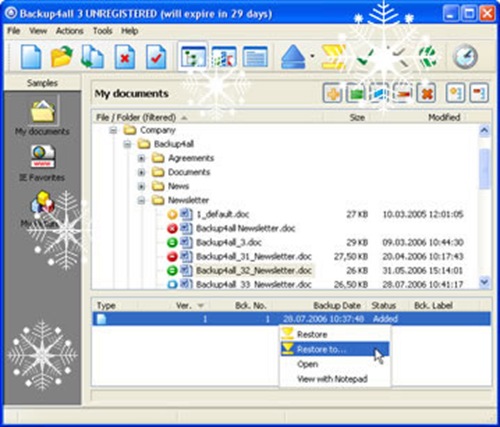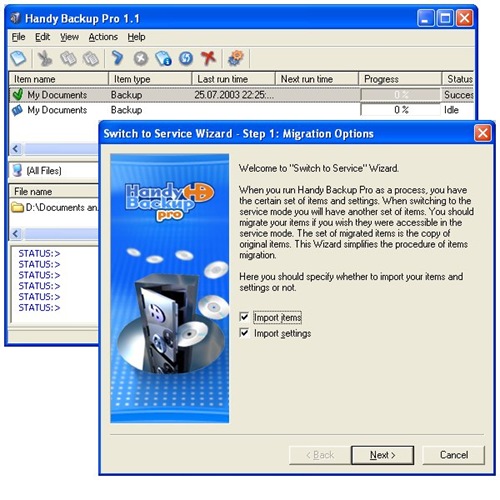Backup Tools for your USB Drive
USB Backup
You can backup your data to a USB drive or from a USB drive using Backup4all. This is a practical backup destination as it allows you to store important files to external devices, offering increased portability.
It can be considered as an additional protection against data loss as the result of hardware failure or other disasters.
Backup to USB or FireWire hard drives
There are external USB hard drives with performance comparable to conventional hard drives. These portable drives (called enclosures) are composed of devices that connect through USB on one side and to conventional hard drives on the other side. A hard drive is installed into the enclosure and then the enclosure is plugged into the computer, thus creating a normal USB backup device. Given the size of nowadays hard drives, this can be considered a mass storage device for backup purposes.
There are external hard drives that beside the USB technology use also FireWire as a connection port. On one side FireWire hard drives tend to have increased speed over USB, but on the other side USB ports are more common on computers.
Steps in backing up to USB drive with Backup4all:
- Start your USB device. Before starting the backup process make sure that the USB drive is started and working. Usually the enclosure should have a start button and display the status of the drive using led displays. When it is started a green led should be lighted.
- Make sure your drive is formatted. If you have just purchased the drive and didn’t use it yet, you might have to format it (only if you didn’t use it before, since formatting will erase everything from it). Formatting the USB drive in Windows XP:
- Go to Start->Settings->Control panel->Administrative tools->Computer Management.
- Under Computer Management click Disk Management then check the right-bottom window (scrolling down if necessary)
- You should see the additional hard drive disk; right-click on it, choose New partition, then follow the instructions to format the hard drive.
- Test to see if the drive is now recognized by going to Windows Explorer (a new drive letter should appear)
- Configure Backup4all. If the drive is formatted and recognized by Windows, it will be recognized by Backup4all too. Now, to backup to the USB drive you should define a backup job in Backup4all that has the destination set to the USB drive. To ensure this, please select the backup job you want to run, press CTRL+P in order to open the Backup Properties window, go to the Destination page and select a drive from the Destination drive drop down list. You can also define a new backup job and in the destination window select the USB drive.
Some USB drives have a button to start the execution of an associated program. If you have such a device you can configure Backup4all to execute a backup job or a backup group when the button is pressed. After the USB drive is ready, go to the Tools->Options menu of Backup4all, select One Touch Backup and press Detect to check if the USB drive is compatible with the One Touch Backup feature of Backup4all.
Backup to USB flash drives
An USB flash drive is a small, lightweight, removable data storage device of up to 8 or more GB, also known as "pen drive", "thumb drive", "flash drive", "USB key" or "memory stick".
In comparison with other removable storage solutions (floppy disks, CD/DVD drive), flash drives are not so easily affected by scratches or dust and even impacts, and plus they offer storage space of up to 8GB or more. This makes them ideal for transporting personal data or work files from one location to another, or for backing up important personal data.
Like all flash memory devices, flash drives can sustain only a limited number of write/erase cycles before failure. In normal use, mid-range flash drives currently on the market will support several million cycles, although write operations will gradually slow as the device ages. This should be a consideration when using a flash drive for backup purposes.
Backup4all can be used for USB backup to a flash drive. Even if the storage size can be of up to 8GB, most of the USB owners have less capacity USB drives, thus is recommended to backup smaller files but that are more important(personal documents, images). Launch Backup4all and either define a new backup job to use as destination the flash drive, or change the destination for an existing backup job. File compression with encryption protection is recommended to be sure that the files are only accessible by the owner and in the event of losing the flash drive the data will not be compromised. Also, to spare storage space, a full backup can be done only once, followed by an incremental or differential backup. Backing up to an USB flash drive is very convenient, since it offers better portability.
Backup4all.Professional.v3.10.283.Multilingual.rar
Backup4all Professional v3.10.289 Multilenguaje.rar
Backup4all_Professional_3.11.300.rar
![]()
Handy Backup equips the user with a whole set of backup features for doing easy backup to a USB flash drive. The option of a 9-level backup zip compression allows the user to substantially reduce the size of the backup set and thus save storage on a USB flash drive.
A 128-bit blowfish encryption prevents unauthorized access the backup data stored on your USB flash drive. Even if someone obtains your USB flash drive without your permission, they will never be able to read the data recorded on it.
Here is the summary of the benefits Handy Backup adds to your USB flash drive backup:
- 9-level zip compression
- 128-bit blowfish encryption
- Full or incremental backup
- Automatic backup on a schedule
- Invisibly as Windows service
- File filters to select most critical data files
Handy Backup Professional 5.8.2.1
USB Image Tool - Backup and restore your USB drives with ease and accuracy.
USB Image Tool can create images of USB memory sticks and MP3 players, that are mounted as USB drives. It allows you switch between images with different music styles on your MP3 Player or to make an exact backup image of your USB Stick.

Features
- create image files of USB drives
- restore images of USB drives
- compressed image file format
- show USB device information
- manage favorite USB images
- Download USB Image Tool Freeware 97 KB
How to Use a USB Flash Drive Useful link about FlashDrive
Category: Appz, BackupManager



















0 comments